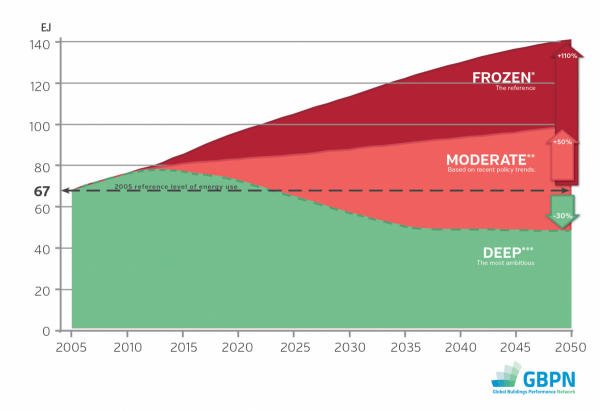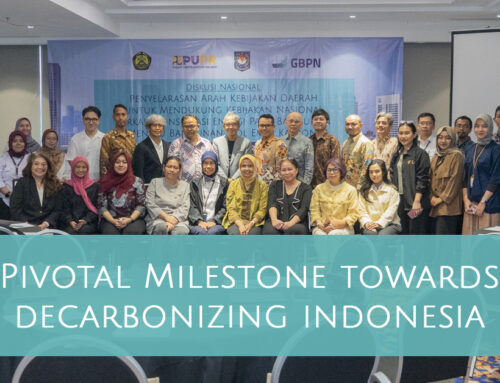2014 Highlights: Why Buildings Matter to tackle Climate Change
Mainstreaming sustainable buildings is essential if we are to effectively tackle climate change and provide sustainable urban environments. Find here an overview of 2014 GBPN main activities & impacts!
Context
According to the IPCC’s Fifth Assessment Report, in 2010 the building sector was responsible for around 32% of final energy use, which equates to 8.8 gigatons of direct and indirect CO2 emissions. Climate change is expected to worsen in the coming years and the buildings sector’s “energy use and related emissions may double or potentially even triple by mid-century due to several key trends”.
What can we do through energy efficiency in buildings to reverse the trend? What is the energy and related emissions mitigation potential globally and in 11 regions around the world up to 2050?
The GBPN Building Energy Performance Scenarios Tool (BEPS) provides the first online interactive module allowing users to search for modelled data for three possible energy mitigation scenarios (Frozen, Moderate (Business-as-Usual (BAU)), and Deep) for the building sector, globally and per region, by 2050. The tool has been developed using a scenario analysis, commissioned by GBPN and produced by the Centre for Climate Change and Sustainable Energy Policy (3CSEP) of the Central European University (CEU).
From a climate change perspective, running an analysis in BEPS reveals for example, that even if we were 100% successful in implementing our current building energy policies (the moderate scenario), we would still increase the total energy demand for thermal comfort in buildings by nearly 50% by 2050 (see figure below), this is in line with the predictions described by the Fifth Assessment Report. However, the green area in the figure represents the “Deep” path and demonstrates that it is possible to reduce the global thermal energy consumption by 30% by 2050 providing mainstream adoption of today’s state of the art policies and technologies are applied.

2014 Main Outputs towards the Deep Path:
Overall the need for building efficiency as core to tackling climate change has reached mainstream awareness and is gaining mainstream political and private sector support. GBPN’s work this year has allowed to turn such talks into walk:
REPORTS
- Contributing author to the IPCC 5th Assessment report WG 3 – Chapter 9;
- Publication of the landmark report on residential energy consumption in India in support of the development of residential building energy codes to support the adoption of residential building energy codes and avoid unsustainable growth in energy demand: Residential Buildings in India: Energy Use Projections and Savings Potentials, Infographics;
- Best-practice ‘How-to’ reports on implementing successful polices for new buildings: Designing and Implementing Best Practice Building Codes: Insights from Policy Makers
- A study of the need for and the benefits of a package of complementary policies to embark on a highly ambitious renovation strategy: Reducing Energy Demand in Existing Buildings: Learning from Best Practice Renovation Policies, Case Studies;
- Co-publication of a global summary on Buildings with BPIE, the University of Cambridge and WBCSD: Climate Change: Implications for Buildings
- Supporting the Major Economies Forum/IPEEC Building Energy Efficiency Task-group (BEET) program to identify priority areas for international collaboration. The recommandations have been included in the G20 2014 Energy Efficiency Action Plan released in November;
- Completion and presentation of the positive energy buildings definitions ‘spectrum as a first step toward a best-practice guide for positive energy policies;
- Report co-published with IMT: Linking Building Energy Codes With Benchmarking and Disclosure Policies, Key Synergies that Drive Building Energy Performance
TOOLS/KNOWLEDGE PLATFORM
- The Policy Tool for Renovation facilitating the comparison and analysis of twelve renovation policy packages for residential buildings from Europe and the United States.
- Releasing the first open-linked on-line scenario model for building energy policies (BEPS): Tool for Building Energy Performance Scenarios
- Relaunched BuildingRating.org web site, as a data driven international portal for the status of building performance policies.
- Ongoing development of the MRV tool with the UNEP (the base-line/future-line Tool or BFA) to calculate energy and emissions base-lines for existing buildings and develop mitigation scenarios as the basis for fundable NAMA programs in the building sector (Nationally Appropriate Mitigation Actions (NAMAs) in developing countries)
- Webinar series on the ‘how-to’ of best-practice policy with the Clean Energy Solutions Centre – and crystallization of webinar outputs into best-practice ‘How-to’ reports on implementing successful polices for new buildings and renovation
- Updating and further expansion of the glossary in English and Mandarin
CHINA
The GBPN China program serviced an MOU with the China’s technical center in charge of reviewing China’s building energy codes (CSTC-MOHURD) to inform the 13th 5yr Plan. GBPN has been supported China’s move to performance-based energy codes and implementation of the Building Energy Performance Standard. Our work in 2014 has supported the analysis of the impact, and continual improvement of building energy polices in China, and creating a stable on-line platform for exchange of best-practices in such policies between China and other countries.
EUROPE
GBPN’s European partner, the Building Performance Institute Europe (BPIE) pursued the mission of reducing CO2 emissions from the building sector in Europe by 400 million tons by 2030 by supporting EU member states to implement the EPBD and EED. In 2014 the BPIE Improved the BPIE Data Hub for Euorpean buildings to establish a Building Data Community and continued his work to monitor EU policy implementation.
UNITED STATES
GBPN’s US partner, the Institute for Market Transformation (IMT) launched the City Energy Project and helped GBPN support the C40 Private Sector Building Energy Efficiency Networks (PSBEEN).
INDIA
Publication of the landmark report on residential energy consumption in India in support of the development of residential building energy codes to support the adoption of residential building energy codes and avoid unsustainable growth in energy demand: Residential Buildings in India: Energy Use Projections and Savings Potentials.
Share This Story, Choose Your Platform!
Stay in touch with how we’re transforming the buildings sector
GBPN runs innovative building policy reform programs in key regions around the world that aim to tackle the climate emergency by decarbonising the buildings sector. Stay up to date with our newsletter.
Stay in touch with how we’re transforming the buildings sector
GBPN runs innovative building policy reform programs in key regions around the world that aim to tackle the climate emergency by decarbonising the buildings sector. Stay up to date with our newsletter.







